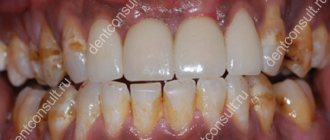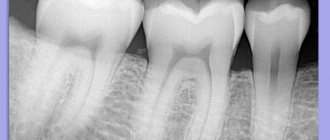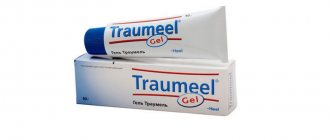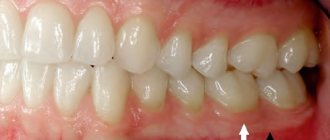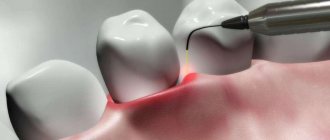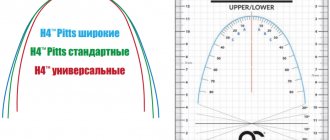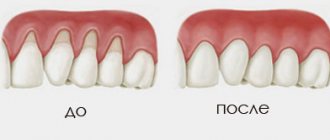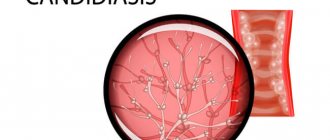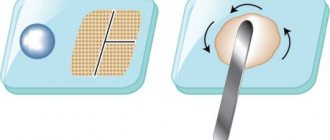4400
In the process of providing therapeutic assistance during dental treatment, the doctor often causes mechanical trauma to the surrounding tissues of the gums and organ enamel.
At the same time, the damage is not accidental; it is necessary for the highest quality of medical procedures.
One of these actions is retraction of the gum area.
What is the procedure?
This is a specific removal of soft tissues from the teeth using certain techniques. Gum retraction is a temporary phenomenon. The procedure is carried out according to the doctor's indications. After treatment is completed, the tissue returns to its place.
However, not everyone can use this method. The doctor decides whether to resort to retraction or not. The cost of the procedure is on average 200 rubles. However, it is important to consider what gum treatment methods exist.
Price
The cost of the procedure is determined by two components - the price of the material and payment for the services of a specialist. How much the manipulation will cost depends on the region of residence of the patient, the clinic, and the qualifications of the doctor. On average, it costs about 550 rubles, excluding painkillers.
Thread price:
- Gingi Pack – from 380 rubles;
- Sure Cord – from 740 rubles.
The video provides additional information on the topic of the article.
Purpose of gum retraction procedure
In medical terminology, retraction is interpreted as the deliberate pulling back of the soft tissue of the gum, as a result of which its groove is subject to artificial expansion.
This, in turn, opens the root part to the required size, and the threshold of the external and internal boundaries of the tooth is significantly lowered.
This method is carried out using special threads made from twisted dense fiber of various thicknesses and sizes.
Devices are produced individually and subjected to high-tech processing.
Is gum retraction harmful?
Retraction is not possible in all cases. General contraindications for gingival retraction include:
- The presence of any coagulation disorders of the blood system (insufficient or increased coagulation), as well as taking anticoagulants.
- The patient has cardiac arrhythmias - in such cases chemical and combined retraction is not performed.
- The presence of an active infectious process in the retraction area.
In such cases, it is recommended to postpone the operation to a later date - until the patient has fully recovered. If the potential risks outweigh the benefits of surgery, retraction is postponed or replaced by another method.
Reviews
Without gum retraction, it is impossible to treat a large number of dental diagnoses; it is difficult to carry out prosthetics and professional hygiene measures.
If you have already experienced the therapeutic benefits of this technique, or you did not like something in the process of its implementation, you can share your own opinion in the “comments” section.
If you find an error, please select a piece of text and press Ctrl+Enter.
Tags gum treatment retraction thread
Did you like the article? stay tuned
Previous article
Basics of electrophoresis for teeth
Next article
Renewing your smile with artistic dental restoration
Composition of retraction thread
The gum retraction technique was first described by scientist Thompson back in 1941. At that time, the dentist practiced using a simple string to increase the size of the gum groove. The specialist first moistened the twine.
At the moment, the threads are impregnated with special agents. Due to this, the gum tissue is pulled back much easier, and the risk of bleeding is eliminated.
The following substances are used for impregnation:
- Epinephrine HCI. Adrenaline is of synthetic origin, promoting vasoconstriction.
- Aluminum chloride. A catalytic substance with binding and antihydrogenating properties.
- Aluminum sulfate. Cleansing coagulating agent.
- Iron sulfate. It has a healing effect if there is not enough iron in the body. Stains the tissues of the oral cavity.
- Double sulfate of aluminum and alkali metal. In colloquial speech, the substance is often called "alum". It has binding and vasoconstricting properties and stops bleeding.
- Zinc chloride. Used as an antiseptic.
- Tannic acid. Used to create a pleasant aroma.
Classification of retraction threads
Manufacturers produce retraction cords in various sizes. Depending on the clinical case, you need to use material of one size or another. For each patient, the gap between the gum and the tooth has different parameters; it differs in size, depth and width. This is also due to the location of the teeth. It is necessary to use only the material that is suitable for each specific situation in order to achieve a high-quality result.
Threads are made from two main materials:
- flax (today such threads are almost never produced);
- cotton paper (the most commonly used type).
Twisted cotton threads
The thread is represented by single or combined bundles of fibers. The material is soft and has an absorbent effect. It is the latter property that is key, which is why such threads are used most often. Due to the special impregnation of the material, bleeding is eliminated. Different manufacturers have different models of such threads.
For example, it offers 3 options:
- Soft-Twist.
- Gingi-Pak.
- Crown-Pak.
Fabric tubes
They are characterized by increased ease of use compared to twisted threads. produces tubes of the Z-TWIST series, which have gained great popularity. This is one of the most advanced technologies. The material contains only cotton fibers. They are braided in a special way for universal use. Such threads easily enter and are held in the gum groove. At the same time, they also have a high absorption effect.
Threads without impregnation
The key characteristics of each thread model are deciphered by markings. Moreover, different shades are used for marking. Depending on the operation, it is necessary to use a thread of a certain color.
uses a special packaging container equipped with a lid with a cutting blade. Thanks to this, 100% sterility of the thread is achieved.
Such material can be used to treat patients who are allergic to certain chemicals. If necessary, the thread can be manually impregnated with the necessary composition. However, it is not recommended to do this, since there is a risk of exceeding the permissible dose. The impregnated material provides a combined expansion of the gum tissue.
Depending on the production technology, retraction threads are also divided into several categories.
Twisted _
The key disadvantage of such models is that they quickly separate into fibers during placement in the gingival sulcus, when used in impressions or when performing restorative operations.
There are several main models of such threads:
- Record from "Vladmiva".
- GingiYarn from Dux Dental.
- Gingi-Pak Cord from Gingi-Pak.
- Pascord from Pascal.
Braided _
More durable compared to previous ones. They practically do not disintegrate into individual fibers during use.
The most popular models include:
- GingiBraid manufactured by Dux Dental.
- Siltrax from .
- Gingi-Pak Braid by Gingi-Pak.
Knitted type ( Woven and Knitted)
They are distinguished by the highest absorbing characteristics. During placement, the thread-shaped loops are gradually compressed, due to which a substance begins to be released into the tissue to stop bleeding. The optimal material for retracting the gums before mechanical treatment of the tooth surface allows you to completely preserve the soft tissues in a healthy state.
Most popular series:
- Gingi-Aid Z-Twist from Gingi-Pak.
- Ultrapak manufactured by Ultradent.
- GingilCnit from .
- Knittrax by Pascal.
Stay-Put
Knitted material. Reinforcing copper wire is used for strengthening. It is distinguished by ease of placement in the groove and stability of shape. Threads are produced with different characteristics, to determine which appropriate markings are used. Depending on the manufacturer and series, markings may vary. For example, Ultrapak, Knittrax Pascal and Gingi-Pak materials are labeled “00”, “0”, “1” and “2”. In turn, for the Pascord Pascal and Siltrax series the markings “7”, “8”, “9” and “10” are used.
Retraction thread Gingi- Pak
This is interesting: Treatment methods for loose teeth in adults
Retraction materials are among the most popular in dentistry. They are made entirely of cotton, are highly durable and easy to use.
The main advantages of the thread from this manufacturer include:
- High-density fabric is used for production.
- During use it does not disintegrate into fibers.
- It has a dark color, which ensures good visibility in the oral cavity.
- Available in special packaging with a cut-off lid. Thanks to this, the absolute sterility of the thread remaining in the package is guaranteed.
- Dense weave.
- Easy to place, the procedure takes up minimal space. Does not stick to dental instruments.
- All series are marked in different shades for ease of choosing a model in each clinical case.
The Gingi-Pak impregnated thread series has the following features:
- Precisely measured amount of impregnating agent. For every 25 mm of thread there is 0.5 mg of impregnation.
- The composition allows you to control and stop bleeding.
Aluminum chloride or epinephrine hydrochloride is used as an impregnating agent.
The manufacturer also produces a series of threads without impregnation. They are used if the patient is allergic to impregnating chemical compounds or if it is necessary to manually select a suitable impregnation, which may be required in certain situations.
Based on thickness, the threads of this manufacturer are divided into series “00”, “1”, “2” and “3”. This allows, among other things, the use of techniques that require the simultaneous use of two threads.
In what cases is thread used?
The need for gum retraction occurs quite often. Moreover, as a rule, no difficulties arise during the operation.
The procedure is carried out in the following cases:
- Eliminating the risk of damage to the gum edge during therapeutic treatment. Also protects against the ingress of gingival fluid.
- Treatment of caries in the area of the tooth neck.
- Obtaining dental impressions for the manufacture of dentures.
- In pediatric dentistry, when it is necessary to eliminate this or that pathology. Usually used only in the treatment of restless children.
- If you need to significantly expose the edge of the gum.
- Removing deposits from the enamel surface (stones, plaque).
- If the soft tissue has grown excessively wide.
- Stop the resulting bleeding.
- Correction of pathologies when the distance between teeth is too small.
Retraction methods
There are 3 main techniques used in dentistry for gingival sulcus retraction. They cause virtually no pain or discomfort to patients. These techniques typically use cotton thread.
Surgical method
The safest way, minimizing the risk of tissue damage. As a rule, this is the technique used. Retraction is usually performed when surgical intervention is urgently needed. The doctor removes excess soft tissue at the edge of the gum using appropriate instruments (scalpels) and equipment (laser). In this case, local anesthesia is used.
Mechanical method
It is used quite often, but has a number of disadvantages:
- traumatic;
- the patient feels pain;
- the fibers of the thread penetrate into the soft tissue during the operation;
- The gum edge is not sufficiently protected when placing orthopedic structures.
This method often uses different types of threads rather than rings because it is difficult to find the right size. Local anesthesia is required to perform the procedure.
Chemical technique
It has a high level of safety and effectiveness, but is not used often, since patients may be allergic to the constituent substances of the products used in the retraction process. For this operation, special gels, pastes and liquid formulations are used. The product is applied directly to the fabric. It passes into the microscopic cavity between the surface of the tooth and the tissue. Under the influence of chemicals, the tissue is pulled back for some time, after which it returns to its original position.
The gels act for no longer than 5 minutes. One of the components is adrenaline. The latter does not have the best effect on the body. If the patient has cardiovascular diseases, the use of such gels is strictly contraindicated.
This may cause the fabric to change color. Do not use excessive amounts of product. It is also necessary to strictly observe the time the composition remains on the fabric. If you overdo it, the tissue will be burned.
Combined method
A fairly common technique. Most often, mechanical and chemical methods are combined. In this case, threads or rings with special impregnation are used.
The advantage of this method is that the tooth surface is exposed for quite a long time. In this case, a mandatory preliminary measurement of the depth and width of the gingival groove is required. You also need to know for sure whether the patient has allergies and/or cardiovascular diseases.
Requirements for the retraction procedure
It is necessary to expand the space between the tooth surface and the gum tissue in such a way that the required amount of impression material can be placed in it during the entire operation of making an impression. To control bleeding, a thread with hemostatic impregnation can be used.
Retraction is a combined operation that includes several effects:
- Mechanical. The tissue is removed mechanically.
- Chemical. The gums are displaced using special chemicals.
- Surgical. Quick removal of excess tissue.
Usually retraction is performed in a short period of time. This requires constant medical supervision. In certain clinical cases, such an operation cannot be performed. Accordingly, the decision to perform retraction must be made based on the specific situation.
Selection of material
Retraction threads in dentistry are selected individually, it depends on the depth and width of the gingival groove. Only a specialist (dentist) can select the thread. Dental sutures for retraction are divided into several types according to the method of twisting:
- knitted;
- wicker;
- twisted.
Knitted threads are fabric tubes. They have high absorption (the property of absorbing liquids). The special weave structure allows for a tight and comfortable fit to the gum groove. When the devices are pre-impregnated with a hemostatic solution, it is released during installation due to the compression of the loops. Some manufacturers produce reinforced products (reinforcement material is copper wire), they fit better on the furrows. Knitted ones are considered the best option for the retraction procedure. Braided ones are durable, and fiber stripping of loops is practically eliminated. Twisted (twisted) cotton consists of grouped or single bundles of fibers. They are distinguished by their softness and the highest absorption, but when used, there is a high probability of fiber disintegration and inclusion of fibers in casts.
Based on the type of material, threads are divided into linen and cotton.
There are many labels for dental floss. Each manufacturer labels them according to their own classification, since there is no single system. Packing – placing a retraction thread in the gingival pocket. There is a double wrap, which involves laying two threads; this method is used for inflamed gums that are prone to bleeding. Let's consider the marking method using the example of Ultrapack knitted thread:
- Ultrapack 000 – ultra-thin, used for double packing, intended for front teeth. Doctors use it to fix veneers. It is suitable for delicate and dense fabrics.
- Ultrapack 00 – thin nodular, used for double packing and restorative operations, such as cementation or veneer preparation. Suitable for thin fabrics prone to tearing.
- Ultrapack 0 – slightly thicker than the previous ones, used for double packing and restoration operations. Often used for lower front teeth. It is recommended in cases of bleeding.
- Ultrapak 1 - the scope of application of this thread is similar to Ultrapak 0, but can be used on premolars with moderate tenderness of the gum tissue. Recommended for crown preparations and as protection before procedures on front teeth.
- Ultrapack 2 is the most used in dentistry. Designed for durable fabrics, used for double packing as a top thread.
- Ultrapack 3 – used in case of thick gum tissues, their installation requires more effort, as well as for double packing.
For the desired effect for one or another type of retraction, dental products are impregnated with a special solution:
- adrenaline (or epinephrine) hydrochloride - has a vasoconstrictor effect, which reduces the volume of soft tissues; people suffering from arterial hypertension should avoid using threads soaked in this solution;
- zinc chloride – has a strong astringent effect;
- aluminum chloride – a water-repellent, astringent substance, intended for working with damaged gums;
- aluminum sulfate - has the same effect as aluminum chloride, but is undesirable for damaged tissues;
- alum double aluminum sulfate - has an astringent, vasoconstrictor, hemostatic effect;
- ferrous sulfate - constricts blood vessels, stops bleeding; use on the front teeth is undesirable, because the solution stains soft tissues.
Products with impregnation are used in cases of long operations; short-term manipulations are performed using unimpregnated threads, but with the preliminary placement of special pastes or gels into the gum pocket using a syringe. Examples of pastes: Retragel, Expasyl, Retrac, MagicFoam Cord and many others.
When it is necessary
When working on a tooth, it is not always necessary to create a complete view from all surfaces. However, in the case of the manufacture of dentures, the treatment of carious cavities and a number of non-carious defects, it is worth resorting to such an intervention as retraction.
Indications for the procedure:
| Orthopedics | Surgery | Therapy | Orthodontics | Other points |
| Obtaining an accurate impression with impression material | Performing surgical intervention on the gums for hypertrophy, plastic surgery | Treatment of caries (II, V) class according to Black, non-carious (erosion, wedge-shaped defect), close to the equator of the tooth | In case of gum hypertrophy and placement of braces | Hemostasis (a set of measures to quickly stop bleeding from the gingival groove) |
| Fixing permanent structures | When whitening teeth |
If we look at the functional purpose of retraction in general, we can say that the procedure is needed to gain access to areas of the tooth that are normally covered by the gum. This is mainly required in the practice of a dentist, therapist and orthopedist, less often than others.
When performing orthopedic work, it is important to accurately track the prosthetic bed. This place designates the entire area that will be covered by the crown. A precisely fitted design will not cause discomfort when worn or the appearance of bedsores.
The process of preparing for the manufacture of a single crown on the lower jaw.
Retraction is mainly needed in the manufacture of crowns, veneers and lumineers. It is especially important to prepare the gums and teeth in the anterior area, since this is an aesthetically important area.
How is it carried out?
Retraction can be performed in several ways:
- operational;
- using a laser;
- chemical;
- mechanical force;
- combination.
Each method has its own characteristics. Surgery in the area of gum tissue is resorted to only in cases of massive hypertrophy and the ineffectiveness of other methods, in which it is impossible to introduce a solution, gel or other substance that can temporarily reduce the attachment of the gum.
Laser is a fairly popular method of treatment in physiotherapy of organs and tissues of the body. Thanks to the precise impact of the beam (V 3.5 W, l wave 10.6 nm), local reduction of the mucous membrane along the dentogingival junction is ensured without pain. Laser is an expensive procedure, so it is not widely used.
This is interesting: Treatment of deep dental caries - pain relief and diagnosis
Exposure to a laser beam.
The most common method of gum retraction is chemical. They use a large number of substances and solutions, combined methods.
The chemical method of exposure is characterized by the use of gels, solutions, pastes, threads, or a combination of several components, applied and injected into the area of the gingival groove. The decrease in the height of the gum tissue occurs temporarily, on average for 2-5 minutes. Gels and pastes are considered the safest in terms of preventing the appearance of further recession, since only local application is carried out, without deepening into the periodontal junction.
Note! The principle of action of all drugs that cause a decrease in tissue volume over time is primarily based on adrenaline. Therefore, before performing retraction in persons with impaired functioning of the cardiovascular system, even when treating carious cavities, permission should be obtained from a cardiologist.
The mechanical effect is based on the introduction of an obstacle into the gingival sulcus, allowing for complete visualization of the crown, neck and beginning of the root. This is achieved through special rings, caps, matrices, and wedges.
The procedure causes discomfort in the patient and, in some cases, bleeding, so in particularly severe cases, infiltration (mostly in the gingival papillae) or conduction anesthesia is administered.
Treatment of class II cavities according to Black, with the installation of a matrix system and wedges against the background of a rubber dam.
Intraseptal anesthesia.
The combined use of different techniques and drugs gives the best results from retraction. Materials impregnated with medications are mainly used, which are aimed at pain relief and stopping bleeding.
Directly about the methodology
The most popular is retraction using threads. The procedure causes minimal discomfort in the patient, allows access to the tooth tissue for 5-10 minutes and does not leave any noticeable changes.
Progress of the intervention:
- View of the tooth using a probe and mirror.
- Determining pocket depth using a periodontal probe.
- Selection of thread taking into account the clinical situation.
- Tear off the thread (about 10 cm), fold it into a loop and apply it to the gum along the entire perimeter in the area of the anatomical narrowing of the tooth (neck).
- Inserting the thread using a thread handler or smoother.
- Wait 1-2 minutes and begin further treatment.
Threads can be laid in 2 options:
- one;
- two.
Installation of the thread in the subgingival area using a trowel.
One thread is used for healthy gums, pale pink in color. The height of the attachment decreases by 0.5 mm.
A double thread is needed for periodontal tissue diseases. Initially, a thinner thread is laid. Then, when partial gum recession occurs, a second one is inserted.
What methods are used to perform dental retraction?
Gum retraction can be performed in the following ways:
- Surgical. The method involves correcting the gingival level using a surgical instrument. The procedure is carried out after an injection of local anesthetic and is recognized as the most traumatic of the existing ones, and therefore doctors rarely resort to surgical retraction. As a rule, excessively overgrown gum tissue is reduced surgically or the gums are corrected in cases where it is not possible to resort to another retraction method.
- Mechanical. The height of the soft periodontal tissue is changed by mechanical action. This technique is quite popular, it is carried out under anesthesia, and rings, threads or silicone caps are used as additional devices that have a mechanical effect on the gum tissue. In modern dentistry, threads are the most common.
- Chemical. As part of this technique, a special chemical in the form of a solution, paste or gel is applied to the gum tissue. Initially, chemical retraction preparations are soft and plastic, but after application to the gum tissue they harden. The hardened material is removed from the gum, and the gum tissue maintains its new position for several minutes. Chemical gum retraction in orthopedics has become widespread; chemical preparations containing kaolin and aluminum oxide are considered the most gentle.
- Laser. The retraction method using a laser device is the newest and most expensive. The procedure involves directing a laser beam at the gum, which causes the gum tissue to move away from the teeth. The laser is painless and safe for the soft periodontal tissues and the patient’s entire body. However, laser retraction is offered by a limited number of dental institutions, since most Ukrainian dentists do not have a laser device.
- Combined. This technique was created in order to minimize the discomfort and consequences of retraction for the patient. Mechanical and chemical retraction methods are mainly used together. In practice, this looks like mechanical retraction, but the patient is fitted with a product impregnated with a chemical preparation.
Types of retraction threads and their installation technique
To change the level of gum tissue, knitted, braided and twisted threads are used. Knitted products are distinguished by their ability to absorb liquid, they are durable and protect the gums well. Braided threads are most often used in orthopedics to make high-quality impressions of teeth. Twisted products are especially strong and may disintegrate into fibers during use. Choosing the optimal retraction thread for the clinical situation is the dentist’s task.
Gum retraction can be performed using one or two sutures. A classic example of the use of two threads is the need to provide manipulations by an orthopedic dentist if the patient has inflammatory processes in the gums. It is possible to limit one thread to prepare for treatment of a patient with healthy gums, but if the gingival tissues are problematic, then the first thread is inserted into the gingival sulcus before preparing the teeth, and the second thread is used after grinding the segments of the dentition.
In order for the impression from the teeth to have distinct boundaries, one thread must be removed before taking the impression, then the impression mass will accurately follow the contours of the gum tissue. Thanks to this, the orthopedic structure, made in accordance with the impression, will be especially tight and reliable.
Gum retraction with floss is performed according to the following plan:
- Measuring the depth of the periodontal sulcus.
- Injection of an anesthetic drug.
- Preparing the thread. Retraction products are sold in small containers to maintain sterility requirements. The doctor opens the container, unwinds and cuts off part of the thread, and treats the thread in a special solution.
- Setting the thread. The doctor slowly immerses the thread under the gum tissue, smoothly bringing it to the desired level. If the patient complains of pain, the doctor gives another injection of anesthetic, and only after complete loss of sensitivity, threads the thread to the end.
- Checking the position of the product. Before starting the main procedure, the doctor must make sure that the retraction thread is in the right place.
- Removing the thread. At the end of the main dental procedure, the dentist picks up the thread with the sharp edge of the instrument, grabs it with tweezers and pulls the product out of the gingival sulcus.
Selection and types of material
The threads can be either completely dry or treated with agents with a therapeutic effect. The last option is used most often.
The choice of product always remains with the specialist - it is he who, based on the clinical situation, will choose the best option.
This is interesting: Caries according to Black: classification of degrees of caries
There are often cases when a patient suffers from individual intolerance to the components of medications, so it is necessary to use dry material.
The qualitative composition of the retraction thread differs by type:
- 100% cotton – treated with compounds that stop bleeding and have a disinfecting effect;
- cotton without impregnation - indicated when other options are unacceptable for clinical reasons;
- Tubular fabric – characterized by increased moisture absorption.
By appearance:
- twisted - not very strong and durable. They often tear, breaking up into individual fibers;
- knitted - indicated for use only to ensure the integrity of soft tissue fragments during dental preparation;
- wicker ones are the most durable and multifunctional products.
Indications and contraindications
The root exposure procedure using pulling threads is indicated in the following clinical cases:
- bite defects of any severity;
- removal of destroyed fragments of the jaw row;
- gum therapy;
- during anesthesia to enhance the targeted effect of the drug;
- with professional whitening in a clinic;
- in the production of veneers and crowns;
- when removing rocky deposits using ultrasonic influence;
- as a manipulation that stops bleeding that occurs during the treatment of surgical actions of a doctor.
Contraindications to the procedure have not yet been thoroughly identified. The main thing that should be adhered to is the absence of inflammatory, purulent and infectious lesions of the soft tissues of the oral cavity.
Stages of staging
The technique of performing tissue retraction is carried out in several successive stages:
- instrumental study of the furrow , replacement of its parameters and required depth;
- administration of an anesthetic drug>;
- preparation of the thread - impregnation with a hemostatic agent, determination of dimensions. Everything is done in strict sterility to prevent infection of the internal layers;
- the product is inserted to a shallow depth , after which the tooth is treated;
Upon completion of all therapeutic measures, the doctor uses a sharp device to pull the end and pull the thread out of the cavity.
Popular manufacturers
The following materials from well-known brands engaged in the production of dental instruments, devices and dental care products have proven themselves better than others:
- Gingi Pack – composition – cotton, impregnation – aluminum sulfate. It has a unique texture, holds firmly in your hands, and does not slip.
The applied composition is distributed along its entire length as evenly as possible, and comes with convenient packaging and a cap that eliminates the need to use scissors.The fibers do not crumble, the fabric is sterile - 100%. If necessary, it can be impregnated with additional composition;
- Sure Cord - its structure is a set of microscopic twisted fibers interconnected into a durable fabric. Fits securely into the groove. Extensive range of sizes, thickness varies in the required range. An ideal solution for installing veneers.
Methods used
In medical practice, several methods are available to retract the soft tissue of the gums. Which one to prefer is the prerogative of the doctor. The decision is made based on the complexity of the diagnosis and the specifics of its treatment.
Mechanical method
The thread is packaged in a special tube and comes with a blade. They are dry and medicated.
Step-by-step algorithm for the doctor’s actions:
- anesthesia of the working surface;
- preparation - determining the length of the bundle, impregnating it with the composition (if necessary);
- packing - to the required depth using a special packer device, the product is delivered to the required place. The manipulation is carried out slowly and carefully. Normally, the patient should not experience discomfort;
- cutting off excess ends with scissors.
The procedure is simple, this is its advantage. Belongs to the category of gentle measures.
Has disadvantages:
- risk of accidental injury to soft tissue mucosa;
- duration in time;
- small fragments of fibers can impair the aesthetic content during subsequent restoration.
Surgical
The method is indicated for pathological growth of soft tissues in the border zone of the gums. This clinical picture makes it impossible to use other techniques.
The manipulation is performed under local anesthesia in a standard manner. The main tool is the surgeon's scalpel.
Modern dental clinics use bloodless laser technology for this purpose, but this service is available only to prestigious medical institutions.
The surgical method is fraught with complications of varying degrees of intensity, the main of which are:
- formation of a purulent pocket;
- development of internal inflammation;
- excessive root exposure;
It has a serious contraindication to the procedure – periodontitis. Retraction is often accompanied by pain.
Chemical
The main purpose of the method is to provide impressions. Additional accessories - a syringe and a gel-based product. Step-by-step introduction technology:
- The paste is drawn into a syringe and distributed into the gum cavity. Then it is lightly pressed down by the coronal part of the organ;
- after a few minutes the mixture is removed, not leaving even small fragments. The working surface is washed with running water;
- the crown dries naturally.
Flaws:
- the risk of chemical burns if the exposure time of the paste is incorrectly calculated;
- the possibility of manifestations of individual intolerance to the components of the product.
The advantage is the speed of manipulation and high results.
Composition of drugs for retraction
- Aluminum sulfate (sulfate). It has water-repellent and astringent properties.
- Iron sulfate. Sharply narrows the capillaries in the gums, quickly stopping the bleeding.
- Zinc chloride has a strong astringent effect.
- Aluminum chloride is used for gum inflammation and damage.
- Epinephrine. Constricts blood vessels, thus reducing bleeding gums.
The most gentle retractors are those containing kaolin and aluminum oxide. These are pastes or gels packaged in cartridges with cannulas, which make it possible to control application to the neck of the tooth. Due to the chemical activity of such products, they are applied for a strictly defined time, specified in the instructions for use, otherwise a chemical burn of the gum mucosa is possible.
In denture practice, surgical and chemical methods are often combined.
Laser Application
The use of a laser for retraction is an innovative method that involves horizontal or vertical dissection of an area of the gum using laser radiation. The dissected tissue is tucked, thus opening access to the neck of the tooth. Thanks to precise laser radiation, local reduction of periodontal tissue is ensured, without damaging adjacent areas.
The method has not gained popularity in dental practice due to its high cost.
Combined method
The combined method of gum abduction is a combination of mechanical and chemical methods and involves the use of threads impregnated with chemical solutions. The method is carried out in one of 2 options:
- use of impregnated threads;
- use threads and gels alternately.
The combined method is aimed at minimizing discomfort and adverse consequences of the procedure for the patient.
The nuances of using retraction dental floss in dentistry
1400
Recently, domestic dentists have been practicing the retraction procedure, which is a reduction of soft tissues in order to slightly open the gum groove for a certain time.
A similar procedure is carried out in various ways using a retraction thread, the characteristics and implementation features of which we invite you to take a closer look at.
Methods
The choice of the method by which the gums will be pulled back with a thread is made by the dentist based on the research results.
Next, the specialist consults the client and begins work. So, in dental practice, four methods of gum retraction are used - mechanical, chemical, surgical and combined. You can learn more about each of them below.
Chemical method
The presented technique involves the use of solutions, pastes and gels, the effect of which leads to a reduction in periodontal tissue.
The drug is usually placed in the periodontal sulcus. The chemical composition includes a small concentration of adrenaline. Therefore, the disadvantage of the procedure is that it cannot be performed for patients suffering from cardiovascular diseases .
Good homeostasis means that the free gum margins are not damaged. The choice of one or another drug is made by the dentist.
In exceptional cases, the selection can be carried out jointly with the patient, in which the specialist focuses on the financial capabilities of the latter, selecting the most suitable drugs for the price.
The solution or paste is administered using a special gun or syringe. Residues are washed thoroughly. Another disadvantage is the possibility of burns.
Combined method
Retraction using a combined method usually includes two options:
- the use of threads pre-impregnated with a drug. The procedure is performed in a dental office. An alternative option is to purchase ready-made threads available at the pharmacy;
- alternate use of gels and threads. First, the dentist widens the periodontal sulcus, after which he applies a special gel or paste to the treated area, using appropriate medical instruments.
Prices
Today, the cost of Sure Cord threads varies from 400 to 450 rubles, depending on the offers of online stores or pharmacies.
For Gingi Pak products you will have to pay about 450-500 rubles. Prices may vary depending on three parameters - the type of binding, the type of production materials, and the length of the product. Products are supplied in plastic packaging.
For the retraction procedure itself you will have to pay approximately 200-250 rubles per tooth. The price includes labor only. The client pays separately for the materials themselves.
You can purchase threads yourself, but before doing so, be sure to consult with your doctor.
The video provides additional information on the topic of the article.
A specialized clinic first conducts a visual inspection, and only then indicates the price along with materials.
Recovery period
The recovery period after the procedure requires adherence to rules that will accelerate healing and prevent the development of inflammatory processes:
- rinsing the mouth with antiseptic and sedatives in the first 3 days after retraction;
- the use of gels that eliminate swelling and soreness of the gums;
- Gently brush your teeth using a soft brush and medicated toothpaste.
During recovery, you should pay attention to the foods you eat:
- After the procedure, it is prohibited to consume hot foods and drinks for 6–8 hours.
- In the first 5 days after retraction, it is recommended to refrain from cold, spicy, and sour foods, which can lead to irritation of the mucous membrane.
- You should not eat too hard foods - nuts, seeds, crackers, as they can damage soft tissues.
If the color of the treated area changes, swelling increases, or pain increases, you should immediately consult a doctor.
Recommendations for the rehabilitation period
The recovery period after using this technique and targeted treatment may include physical discomfort, pain, bleeding, and swelling of the mucosal tissue.
To minimize these sensations, you should use products that strengthen the gums and relieve inflammation:
- medicinal ointments and gels;
- rinsing with decoctions of medicinal plants;
- in difficult cases - a course of antibiotics.
Teeth should be brushed only with a soft brush, with pastes that do not contain abrasive and whitening components, preferably on a professional basis.
Carefully remove food residues by rinsing and using an irrigator in a gentle mode.
You should avoid eating too cold, hot foods and drinks, hard, sticky and viscous foods that can injure the affected areas.
Possible complications
- The inflammatory process in the treatment area occurs when the periodontal margin is thin. In this case, it is better to abandon mechanical retraction and use chemical one.
- Aggravation of the situation with hidden or undetected periodontal disease in the initial stage.
- The roots of the tooth are exposed, at least partially. A complication occurs after the threads are packed too deeply during retraction.
- Professionalism of the dentist; quick, “spotless” manipulations, confidence in actions and the ability to calculate their consequences.
- Taking into account the immune system and the ability to strengthen it with the necessary drugs in advance. Usually a weekly vitamin course is prescribed.
- Correct post-procedure measures, care of the required quality.
